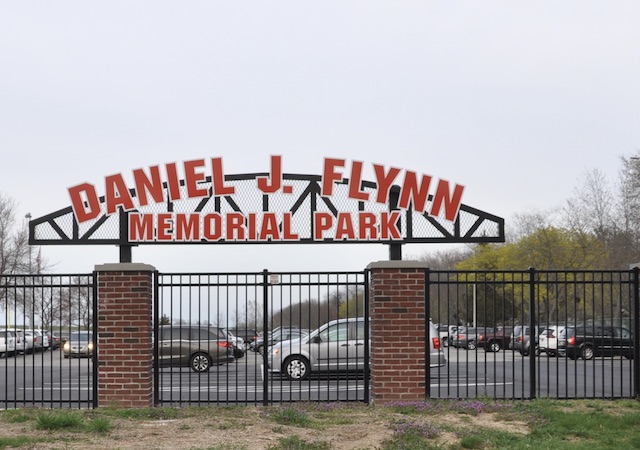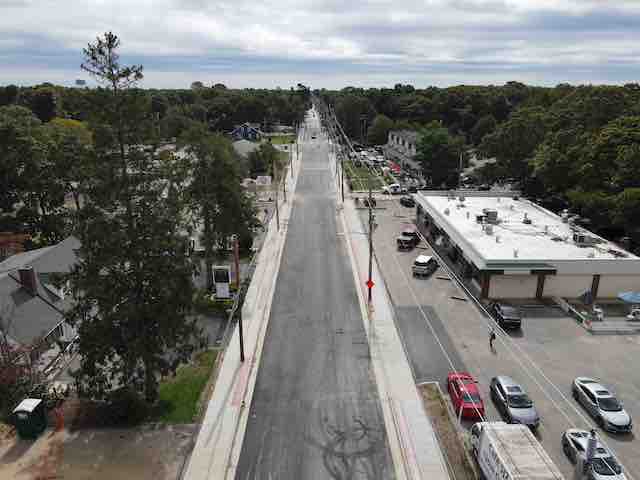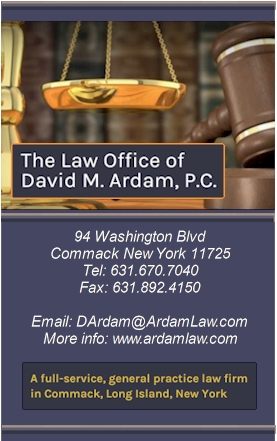News of Long Ago by Bradley Harris, Smithtown Historian
(April 15, 2012 is the 100th anniversary of the day that the Titanic sank in the North Atlantic. This article deals with the story of James Clinch Smith, the son of the Judge John Lawrence Smith who was lost on the Titanic that fateful day one hundred years ago. In last month’s article, I traced the story of James Clinch Smith’s childhood and upbringing, followed his career as a lawyer, and wrote about his marriage in 1895 to a beautiful young heiress from Chicago named Bertha Barnes. This article tells the rest of the story of James Clinch Smith’s life and death.)
“James Clinch Smith, lost on the Titanic…”
In June of 1895, James Clinch Smith and Bertha Barnes were married at a lavish wedding in Grace Church in Chicago. 2,500 people attended the wedding including most of Chicago’s leading citizens. Following a reception that was held at the Barnes’ home, the happy couple was off on their honeymoon.
The couple spent part of their honeymoon in New York City, then came out to the Homestead in Smithtown, and then went on to Newport and Europe. When they returned from Europe, they settled into married life at the Homestead. James was happy back in familiar surroundings with his sisters all around him. He wanted nothing more than to again pursue his love of sports, horse-racing, sailing, polo matches, riding to the hounds – he wanted to do it all. He was quite content in Smithtown but Bertha didn’t like the cultural wasteland of Smithtown. She wanted to recapture all the fun and frivolity that she had enjoyed as a wealthy young debutante in Chicago. Bertha hated winters in Smithtown and the Smiths started spending time with friends in Aiken, South Carolina.
In 1898, they built a house in Aiken where they could stay for the fall and winter. In 1900, they purchased a house in Newport where they spent their summers. Then in 1901, they began construction of a new home in Meadow Brook – a mansion that took three years to complete. The mansion had 31 rooms with 14 bedrooms and seven bathrooms, all done in white and gold. Stables were built to house Smith’s polo ponies and riding horses and it even contained an indoor riding track. When the house was finished in 1903, James Clinch Smith moved in, richly furnished the house, and anxiously awaited Bertha’s return from Europe. Bertha had gotten ill on a visit to her mother in Chicago, and “for a cure” she spent the summer of 1903 recuperating at a spa in Germany. She returned to New York in the fall of 1903 and joined James in their new mansion at Meadow Brook. But one winter in Meadow Brook and she decided she didn’t want to live in America.
So in the spring of 1904, James Clinch acceded to Bertha’s wishes, sold all his horses, carriages, saddles and harness, and announced that he and his wife were moving to Europe. The Smiths rented their new mansion to a friend and sailed to Europe where they settled in Paris. They bought a house at 4 Villa Said just off the Champs D’Elysee. Here Mr. and Mrs. James Clinch Smith were often seen “riding smart mounts in the boulevards.” James continued to pursue his interest in horses and riding while Bertha renewed her interest in music and composing. It was at this time that Bertha organized a “music club of American girls in Paris” and began gathering musicians to form an orchestra of women. Bertha composed the music and directed the orchestra which created quite a stir in Paris. On December 17, 1905, in the rooms of Chez Brentanos at the Washington Palace, 14 Rue Magellan, the “Orchestra de Dames” performed an evening concert for the benefit of a retirement home for French artists. The concert was well received and reported around the world, and Bertha’s “music madness,” which James Clinch heartily disliked, began to lead to tension in their marriage.
The Smiths were in Paris in the fall of 1905 when their mansion in Meadow Brook burned to the ground on Thanksgiving night. All that remained of their beautiful new mansion was one brick chimney. This calamity only compounded difficulties between James and Bertha. James wanted to return to Long Island, while Bertha wanted to remain in Paris until her “Orchestra de Dames” performed on December 17th. Following the concert, in January of 1906, the Smiths returned to their home in Smithtown Branch to see what they could salvage of their mansion in Meadow Brook. But after a short stay, Bertha who was determined to return to Paris and her women’s orchestra, left Smithtown Branch and went back to Paris. James Clinch Smith remained in New York City. James was involved in a legal battle over serving as an executor of an estate and had to resolve the issue before returning to Europe.
He was still in New York City six months later, on June 25th, when he was invited to attend the opening night of a new musical, “Mamzelle Champagne,” at the rooftop theater of Madison Square Garden. By a perverse twist of fate, James Clinch was sitting just behind his brother-in-law, Stanford White, watching the show, when Harry Thaw appeared and shot Stanford White at point blank range killing him instantly. As an eye-witness to the murder, James Clinch was called to appear at Harry Thaw’s trial for murder and had to remain through the lengthy proceedings. Eventually, after almost a year had passed, James returned to Paris to be with Bertha. By this time, Bertha was deeply committed to writing, composing, and directing her own musical compositions, and several waltzes she created were popular throughout France. James tried everything he could to get Bertha to give up her music madness, but was unsuccessful.
By 1911, James Clinch had had enough of the life Bertha wished to lead in Paris and he decided to return to Smithtown. He left Bertha in Paris and returned to his family’s homestead in Smithtown Branch. He had been away for ten years. In a news story that appeared in the Brooklyn Eagle, on June 18, 1911, James Clinch Smith expressed his desire “to spend the season quietly at his fine old ancestral home, and at the same time to keep keenly alive to everything that” was “going on in the world of sports.” He had no intention of rebuilding the mansion in Meadow Brook and wanted to make the old place in Smithtown Branch “his permanent summer home, and there will gather the finest stable of polo ponies, hunters and show horses that will be found anywhere on Long Island.” The article stated that Mr. Smith intended to “take his place as a leader in the town, which his ancestors settled and for whom it is named.” (“Society Man Returns to Old Homestead,” Brooklyn Eagle, June 18, 1911.)
James Clinch Smith quickly made his presence felt in Smithtown Branch. “For the first time in many years,” there was “life and gayety” at the Smith family homestead. James Clinch became involved in organizing “the Smithtown Polo Club, and two afternoons a week,” he was “seen playing polo on the field used by the Smithtown Horse Show.” They were preparing for matches with other Long Island teams that were officially recognized by the United States Polo Association. “Meadow Brook, Piping Rock, Great Neck, Islip and Rockaway” all had been officially recognized as polo clubs when the Smithtown Polo Club applied for official recognition in 1912. Unfortunately James Clinch Smith didn’t live to see this recognition conferred on the polo club he had helped to create.
In January of 1912, James Clinch received a letter from his wife asking him to return to Paris since she had become ill with pleurisy. (It was later discovered that she had tuberculosis.) James sailed for Paris on January 24, 1912. After rejoining his wife in Paris, he convinced Bertha to return to the States with him and booked passage for the return trip on the Titanic. At the last minute, Bertha decided to stay in Paris letting James sail ahead so that he could prepare the homestead in Smithtown Branch for her arrival.
On the evening of April 10, 1912, James Clinch Smith boarded the Titanic at Cherbourg, France for the trip home. Two days later, on April 15, 1912, the voyage came to a tragic end when the Titanic struck an iceberg and sank in the frigidly cold waters of the North Atlantic. 1517 passengers drowned that night, James Clinch Smith among them.
That may seem like the end of the story, but it’s not, because we actually know how James Clinch Smith died that night. His friend and traveling companion, Colonel Archibald Gracie, who survived the disaster, was with James Clinch Smith as the ship slid beneath the waves and he wrote about that night in a book entitled The Truth About the Titanic that was published in 1913. It happens that Colonel Gracie and James Clinch Smith were table companions on the voyage. According to Colonel Gracie, James Clinch Smith was with him “from the beginning of the voyage until the end of it.” Here is Colonel Gracie’s account of what happened to James Clinch Smith:
“On the night of the terrible disaster when I came upon the deck after having been aroused from my slumbers, I met Smith, and we made an agreement to stick to each other through thick and thin. We first realized the gravity of the situation while we were still on a lower deck when we noticed the list the ship gave toward the port side. We took up our station on the port side of the boat deck, at the bow end, near where women and children were being loaded into one of the boats. Here, without any seeming fear whatsoever, Smith stood and he and I helped lift women and children and babies over the rail as each boat was loaded and then lowered. Toward the last, when the list of the vessel became such that Second Officer Lightoller ordered all passengers to the starboard side, Smith at once obeyed and I followed. Here he calmly took in all that was being done by the crew in an attempt to launch a collapsible canvas boat that had been slid down from the hurricane deck, and he and I helped. Before the boat could be launched, the water was upon us.”
“When Smith and I saw that there was little chance of getting the boat and that it would be overcrowded, when we heard and saw the water rise to the boat deck, we decided to move toward the stern. Still on the starboard side, but our progress was blocked by a mass of humanity, which suddenly appeared from the decks below and consisted of second class or steerage passengers.”
“Behind us the water approached rapidly, and we entered a cull de sac to which the only outlet was the bridge deck above. Smith tried to reach it by jumping and so did I, but the height was too great for us. The water was now upon us and just as it struck I rose with a jump at the same time, and was carried high up, when I grasped the brass railing around the bridge deck and held on with might and main.” “Then I looked hastily to the right and left, but Smith was gone. I never saw him again. Undoubtedly he was engulfed by the waters and went down with the ship.”
“Words fail to express the feelings of admiration which I have for his conduct, and the highest tribute I could pay him is this plain recital of what he did in the way of self-sacrifice, knowing no such word as fear in saving the lives of others.” “His relatives and friends should be proud of him and his record in this terrible disaster.” (New York Sun, April 25, 1912.)
His body was never recovered and the Titanic became his burial tomb. A memorial service for James Clinch Smith was held at the St. James Episcopal Church on May 11, 1912. Bertha came to the memorial service and to settle her husband’s estate. Upon James’ death, Bertha inherited the mansion in Newport, the Paris residence on the Champs D’Elysee, as well as the residue of James’ estate valued at $837,776.47. One newspaper account estimated the residue to be $493,337. It didn’t take Bertha long to settle the estate and then she returned to Paris to live with her parents. By the fall of 1912, Bertha’s “illness” had become much worse and she went to a sanitarium in Leysin, Switzerland to be treated for tuberculosis. She died there in August 19, 1913. It was said that the real cause of her death was “a broken heart.” Bertha was buried with her family in Graceland cemetery in Chicago.
 Sunday, October 20, 2013 at 10:53PM
Sunday, October 20, 2013 at 10:53PM  Site of the former Bavarian Inn in RonkonkomaThe Bavarian Inn is no more. The boarded up, graffiti laden building has been demolished. A few more weeks and all traces of the former restaurant/catering facility will be gone. People who live around the blighted site are relieved. Legislator John Kennedy held a press conference on the day the demolition began attended by many local officials. Pats on the back all around as the elected officials enthusiastically announced their support for the demolition and their relief that the blighted and dangerous building would no longer negatively impact on the community.
Site of the former Bavarian Inn in RonkonkomaThe Bavarian Inn is no more. The boarded up, graffiti laden building has been demolished. A few more weeks and all traces of the former restaurant/catering facility will be gone. People who live around the blighted site are relieved. Legislator John Kennedy held a press conference on the day the demolition began attended by many local officials. Pats on the back all around as the elected officials enthusiastically announced their support for the demolition and their relief that the blighted and dangerous building would no longer negatively impact on the community. 






